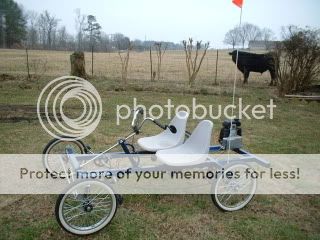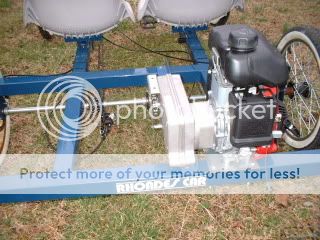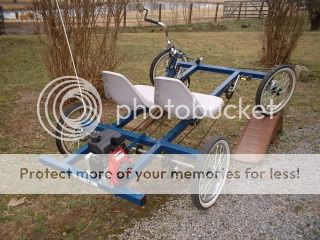bamabikeguy
Active Member
Prob #1- the stalling is apparently a super-sensitive oil sensor, I'm supposed to:
a) find the instruction book
b) read the instruction book
c) circle the solution if the customer wants to snip the wire.
Prob #2 - finding a longer throttle cable locally.
a) called Gary's Small Engines, machine tells me he is mostly out of town in the winter.
b) phoned Greencraft engine repair, they tell me to call Gary
c) phoned Bennett small engine, they tell me to call Gary
Luckily, Rucio the recumbent, has a 120" cable with barrel end, tooooo long (it goes under the pedals). So I'll simply switch them.
Prob #3 - Friday was "go to town day", didn't get home till dark. Dave Staton had sent me 5 e-mail responses, (followed up by him calling me Saturday morning.)
He told me NOT to drive the 4 wheeler until I brace that housing...that the base of the engine was not that thick, and if there was a sudden jolt, perhaps that base could crack.
His e-mail
I had already planned to brace it, before going to town I had measured the gap and looked for 3/4" square tubing to install under the chain gear.... & Dave told me over the phone not to leave any clearance under it.
Then Jack said he was going to bring a special kind of bit to elongate our mounting holes, supposed to do a better job than my drimel.
So, we will have chain adjustment ability.
Oh, and that ball at the end of the throttle cable? Another case of "instructionbookitus" according to another Staton email.....
a) find the instruction book
b) read the instruction book
c) circle the solution if the customer wants to snip the wire.
Prob #2 - finding a longer throttle cable locally.
a) called Gary's Small Engines, machine tells me he is mostly out of town in the winter.
b) phoned Greencraft engine repair, they tell me to call Gary
c) phoned Bennett small engine, they tell me to call Gary
Luckily, Rucio the recumbent, has a 120" cable with barrel end, tooooo long (it goes under the pedals). So I'll simply switch them.
Prob #3 - Friday was "go to town day", didn't get home till dark. Dave Staton had sent me 5 e-mail responses, (followed up by him calling me Saturday morning.)
He told me NOT to drive the 4 wheeler until I brace that housing...that the base of the engine was not that thick, and if there was a sudden jolt, perhaps that base could crack.
His e-mail
Paul, You should NOT use the engine only to attach the kit.
The engine base will break in time and it could break very soon, the next time you drive it. I would NOT drive it again.
We made a mounting plate for the GX100 that had slots for the engine base and most important we made a slotted bracket to support the gear box to support the load on the output sprocket and not transfer the load only to the base of the engine.
The way you mounted it all the pressure is on the engine base and they will break and damage the engine. You also do not have any chain adjustment.
You need to use the two fulcrums on the gear box to handle the load - pressure on the chain.
David
I had already planned to brace it, before going to town I had measured the gap and looked for 3/4" square tubing to install under the chain gear.... & Dave told me over the phone not to leave any clearance under it.
Then Jack said he was going to bring a special kind of bit to elongate our mounting holes, supposed to do a better job than my drimel.
So, we will have chain adjustment ability.
Oh, and that ball at the end of the throttle cable? Another case of "instructionbookitus" according to another Staton email.....
Now cut off the "Ball end" off the inner cable. Place the outer cable to the engine using the conduit clip, bolt & nylock. Then run the cable thru the cable swivel. Leave about 2" extra of inner cable past the cable swivel then crimp the Alloy cable tip to keep the cable from coming undone or poking you.
How to shorten the 90" long cable. Cut the "ball end " off the end of the cable. Remove the "inner" cable from the outer casing. Measure the correct length of outer casing you need. Be sure and have large round bends, never sharps turns or sharp bends or the cable will bind. Cut the outer casing to the correct length, then install the inner cable from the end you cut. Place the "Barrel" of the inner cable is placed in the small black throttle lever or twist grip. With the inner cable sticking out of the outer casing, attach the outer casing to the engine using the conduit clip, bolt & nylock. Then run the cable thru the cable swivel. Leave about 2" extra of inner cable past the cable swivel & crimp the Alloy cable tip to keep the cable from coming undone or poking you.
Last edited by a moderator:














